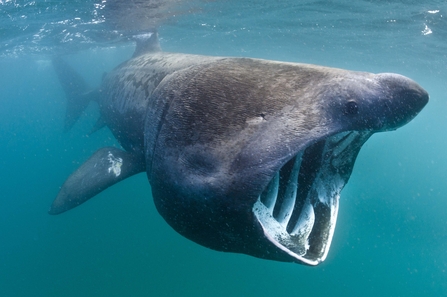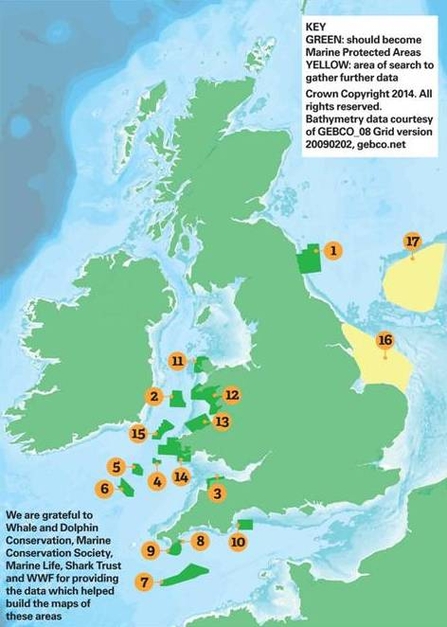New report highlights need to protect important places for dolphins, whales and basking sharks.
Megafauna hotspots: the missing link in marine protection
Humpback whale ©Gillian Day

Basking shark ©Alex Mustard/2020VISION
Save Our Ocean Giants – the protected areas we need for dolphins, whales and basking sharks explains why The Wildlife Trusts want to see these newly identified hotspots (special areas on which whales, dolphins and basking sharks most depend) protected by law. This would secure the missing link in marine protection for English and Welsh waters.
The UK Government is working towards achieving an ‘ecologically coherent network of Marine Protected Areas’, however, there’s a glaring omission in this process: the absence of protection for the nutrient-rich and highly productive places on which marine megafauna most depend.
Many people are surprised to discover that in the waters surrounding our shores you could encounter 29 different species of whale, dolphin and porpoise and the second largest shark in the world – the basking shark
Joan Edwards, The Wildlife Trusts’ Head of Living Seas, said:
“Many people are surprised to discover that in the waters surrounding our shores you could encounter 29 different species of whale, dolphin and porpoise and the second largest shark in the world – the basking shark. However, there’s an urgent need to create protected areas at sea for our ocean giants and ensure a network of sites to safeguard these species for generations to come.
“The UK has made huge advances in marine conservation in recent years but there is still a significant job to do. Our marine megafauna - whales, dolphins, porpoises and basking sharks – are still under threat. Many are suffering from the impacts of fishing, whether direct or indirect, increased boat traffic, marine developments and the more persistent effects of pollution - many substances bioaccummulate and affect generations of animals and overall population health.
“Not all of these impacts can be mitigated by spatial protection measures alone but, by designating areas of the sea which are known hotspots, we can provide safe havens for these species and some impacts can be limited or removed altogether.”
The ‘megafauna hotspots’ The Wildlife Trusts want to see protected are:
- Farnes East, Coquet to St Marys – notable for white-beaked dolphin, harbour porpoise and minke whale.
- Mid St George’s Channel – notable for common dolphin.
- Bideford North to Foreland Point – notable for harbour porpoise.
- East of Celtic Deep – notable for common dolphin and fin whale.
- Celtic Deep – notable for common dolphin and fin whale.
- South of Celtic Deep – notable for common dolphin and fin whale.
- Western Channel – notable for common dolphin, humpback whale and fin whale.
- Manacles – notable for basking shark, harbour porpoise and (seasonally) minke whale.
- Lizard, Western channel – notable for common dolphin, harbour porpoise, bottlenose dolphin and basking shark.
- Lyme Bay – notable for harbour porpoise.
- North and west coasts of Anglesey – notable for harbour porpoise.
- Lleyn Peninsula and the Sarnau – notable for harbour porpoise and Risso’s dolphin.
- Cardigan Bay – notable for harbour porpoise.
- Pembrokeshire Marine – notable for harbour porpoise.
- North of Celtic Deep – notable for common dolphin.
- Eastern coastline including Silver Pit – notable for harbour porpoise.
- Dogger bank – notable for harbour porpoise and white-beaked dolphin.
The Wildlife Trusts are urging the public to sign an e-action which calls on the Government to protect the 17 megafauna hotspots around our shores to secure a brighter future for dolphins, whales and basking sharks.

Map showing ‘megafauna hotspots’
The areas marked on this map are the megafauna hotspots that The Wildlife Trusts would like to see protected. Some of these places already have designations – whether as Marine Conservation Zones, Special Areas of Conservation and more – but unfortunately whales, dolphins and basking sharks are not listed as ‘features’ to be protected within them.
This is why we are calling for either new conservation areas, or for these species to be recognised and protected within existing designated areas.
For a more detailed map, please see the full technical report Megafauna hotspots: the missing link in our network of Marine Protected Areaswhich is available to download here.
Contact information:
Anna Guthrie, Media & PR Manager, on 01636 670075 / 07887 754659 / aguthrie@wildlifetrusts.org
Emma Robertshaw, Media Officer, on 020 3603 6785 / 07779 657515 / erobertshaw@wildlifetrusts.org
Images are available for use with this news release. They are granted on a one-time use basis, in association with this release and the photographer must be credited.
Notes for editors:
Background
The Marine and Coastal Access Bill became an Act in 2009. This piece of legislation provided the framework within which to designate Marine Conservation Zones (MCZ) in English and Welsh waters. The Act was followed by similar legislation in Scotland (2010) and more recently (2013) in Northern Ireland. This saw a step-change in the way which governments protect and manage our seas. And so the MCZ network projects were born, covering the North Sea, South East, South West and Irish Sea for English waters. However, these projects were limited by the features lists produced – sites were not put forward to protect everything in them, rather to protect specific features which occur within site boundaries – and these feature lists do not include the marine megafauna.
Under the Birds and Habitats Directive the UK has the power to designate Special Areas of Conservation (SAC). To date there is one SAC designated for bottlenose dolphin in Cardigan Bay but no others within English and Welsh waters. Whales, dolphins, porpoises and sharks have been overlooked, despite their size and charismatic nature, falling between the gaps in our legislative processes, in part because of their mobile nature and the controversy which surrounds spatial protection measures for mobile species.
We have come a long way since December 2009, with 27 MCZs being designated in the first tranche and a further 37 proposed for the second tranche (up for consideration in January 2015), but still none of these sites list any of the mobile species covered in The Wildlife Trusts’ report – a significant missing link in steps towards our commitments to achieving an ecologically coherent network. This network cannot be coherent - representative of everything - without the large apex predators. The Wildlife Trusts recognise, as did some of those involved in the MCZ network projects, that not all sites are suitable to be designated as MCZs, particularly where there is already SAC designation on a site and so this report makes a number of recommendations across the designations. The Wildlife Trusts’ report provides the all-important missing links across the board, pushing for spatial protection across English and Welsh waters.
